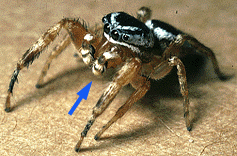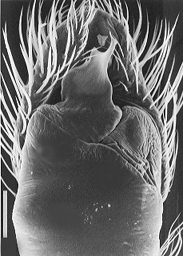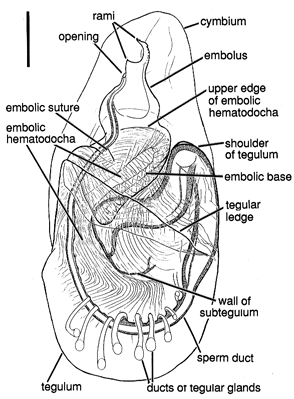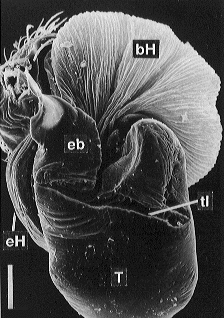Go to jumping spider anatomy page
Male spiders have an unusual way to get sperm into the females: they
use their palpi, the little 'feelers' beside the face. This photo shows
where the palpi are (see the arrow).


In the females, these palpi are simple and leg-like. Both males and females use them like little hands, to manipulate food and to clean their faces.
But adult males have the palpi swollen and more complex (that's one
way to tell a male spider: adult and subadult males have the palpi swollen
like boxing gloves). If you look at the tip of male palpus, from the
underside, you see a complex organ that looks like this:


Before I explain how it works, let's see more of its structure. Here
is a closeup of the palpus, seen under a scanning electron microscope.


The undersurface has various hard bits and pieces put together in
a species-specific sculpture. If you look inside the palp by making
it crystal-clear, you see all the following details.


The important thing to notice is the opening and the sperm duct. When the male is ready, he spins a small web and deposits a drop of sperm on it from the underside of his abdomen. He then places the tip of the palp into the sperm, and draws the sperm through the palp's opening into the sperm duct of the palp. There it is stored.
The male then goes out in search of females. If he finds one, he performs
a courtship dance. If she
accepts him, he places his palp against an opening on the underside
of her abdomen (her epigynum). He locks it
in place by putting a thumb-like projection, the tibial apophysis, into
a groove that is usually at the back of her epigynum. The palpus then
expands. This happens because the various hard bits of the palp are
connected to one another by expandable balloons. When they expand by
increasing blood pressure, the hard bits move into position to inject
the sperm into the female. Here is an image of an expanded palp:


The codes "bH" and "eH" refer to two of the expandable balloons. "eb" is the tip of the palpus, the part that injects the sperm into the female.
* Included on this page are images from Maddison, W.P. 1996. Pelegrina Franganillo and other jumping spiders formerly placed in the genus Metaphidippus (Araneae: Salticidae). Bulletin of the Museum of Comparative Zoology. l54(4): 215-368. These images are copyright © 1996 The President and Fellows of Harvard College.
Jumping spider anatomy pages:
[Anatomy] [External] [Muscles] [Gut] [Vision] [Palpi] [Epigyna] [Gallery]



 Go to quick links
Go to quick search
Go to navigation for this section of the ToL site
Go to detailed links for the ToL site
Go to quick links
Go to quick search
Go to navigation for this section of the ToL site
Go to detailed links for the ToL site